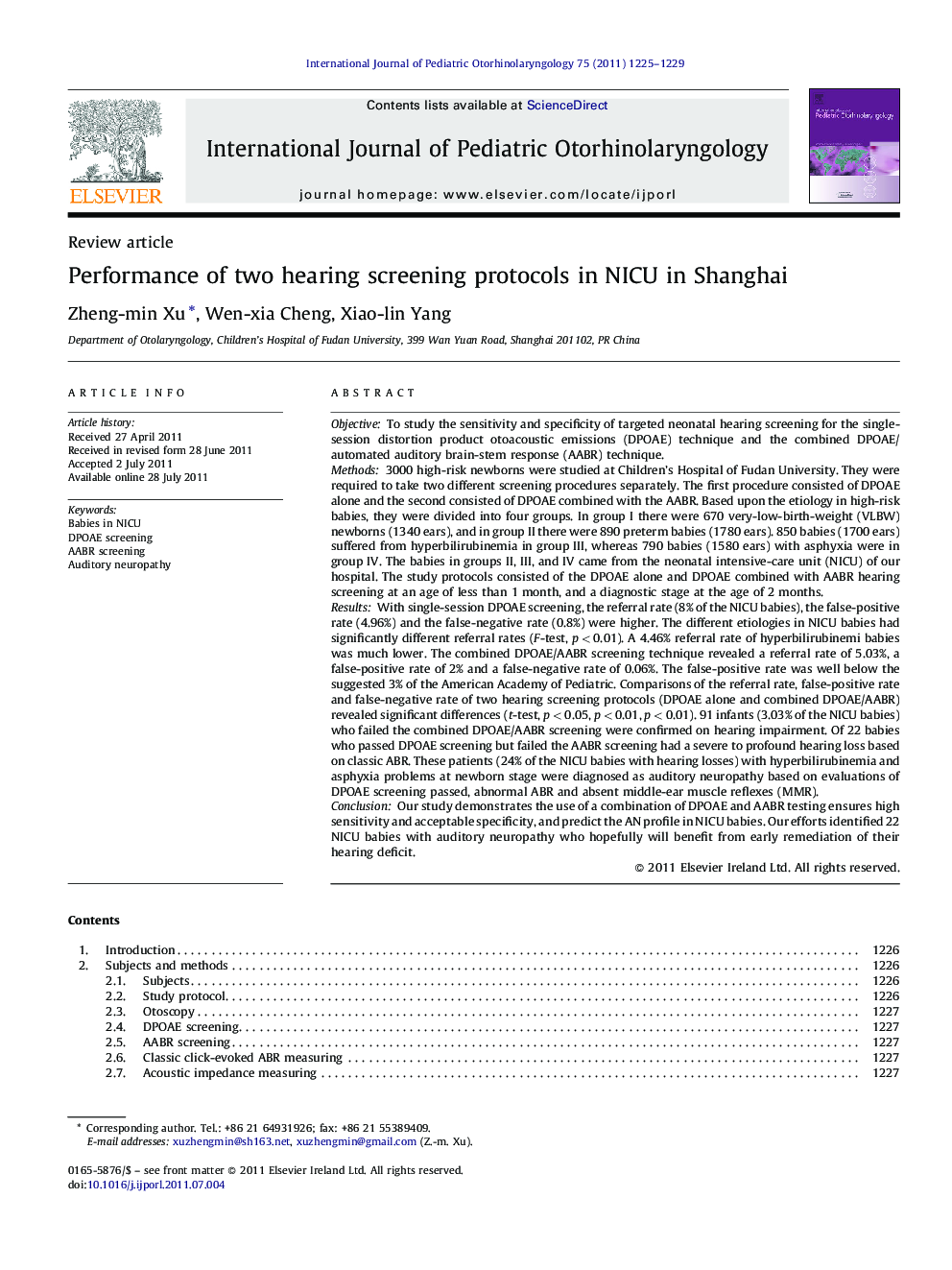| کد مقاله | کد نشریه | سال انتشار | مقاله انگلیسی | نسخه تمام متن |
|---|---|---|---|---|
| 6214188 | 1606040 | 2011 | 5 صفحه PDF | دانلود رایگان |

ObjectiveTo study the sensitivity and specificity of targeted neonatal hearing screening for the single-session distortion product otoacoustic emissions (DPOAE) technique and the combined DPOAE/automated auditory brain-stem response (AABR) technique.Methods3000 high-risk newborns were studied at Children's Hospital of Fudan University. They were required to take two different screening procedures separately. The first procedure consisted of DPOAE alone and the second consisted of DPOAE combined with the AABR. Based upon the etiology in high-risk babies, they were divided into four groups. In group I there were 670 very-low-birth-weight (VLBW) newborns (1340 ears), and in group II there were 890 preterm babies (1780 ears). 850 babies (1700 ears) suffered from hyperbilirubinemia in group III, whereas 790 babies (1580 ears) with asphyxia were in group IV. The babies in groups II, III, and IV came from the neonatal intensive-care unit (NICU) of our hospital. The study protocols consisted of the DPOAE alone and DPOAE combined with AABR hearing screening at an age of less than 1 month, and a diagnostic stage at the age of 2 months.ResultsWith single-session DPOAE screening, the referral rate (8% of the NICU babies), the false-positive rate (4.96%) and the false-negative rate (0.8%) were higher. The different etiologies in NICU babies had significantly different referral rates (F-test, p < 0.01). A 4.46% referral rate of hyperbilirubinemi babies was much lower. The combined DPOAE/AABR screening technique revealed a referral rate of 5.03%, a false-positive rate of 2% and a false-negative rate of 0.06%. The false-positive rate was well below the suggested 3% of the American Academy of Pediatric. Comparisons of the referral rate, false-positive rate and false-negative rate of two hearing screening protocols (DPOAE alone and combined DPOAE/AABR) revealed significant differences (t-test, p < 0.05, p < 0.01, p < 0.01). 91 infants (3.03% of the NICU babies) who failed the combined DPOAE/AABR screening were confirmed on hearing impairment. Of 22 babies who passed DPOAE screening but failed the AABR screening had a severe to profound hearing loss based on classic ABR. These patients (24% of the NICU babies with hearing losses) with hyperbilirubinemia and asphyxia problems at newborn stage were diagnosed as auditory neuropathy based on evaluations of DPOAE screening passed, abnormal ABR and absent middle-ear muscle reflexes (MMR).ConclusionOur study demonstrates the use of a combination of DPOAE and AABR testing ensures high sensitivity and acceptable specificity, and predict the AN profile in NICU babies. Our efforts identified 22 NICU babies with auditory neuropathy who hopefully will benefit from early remediation of their hearing deficit.
Journal: International Journal of Pediatric Otorhinolaryngology - Volume 75, Issue 10, October 2011, Pages 1225-1229